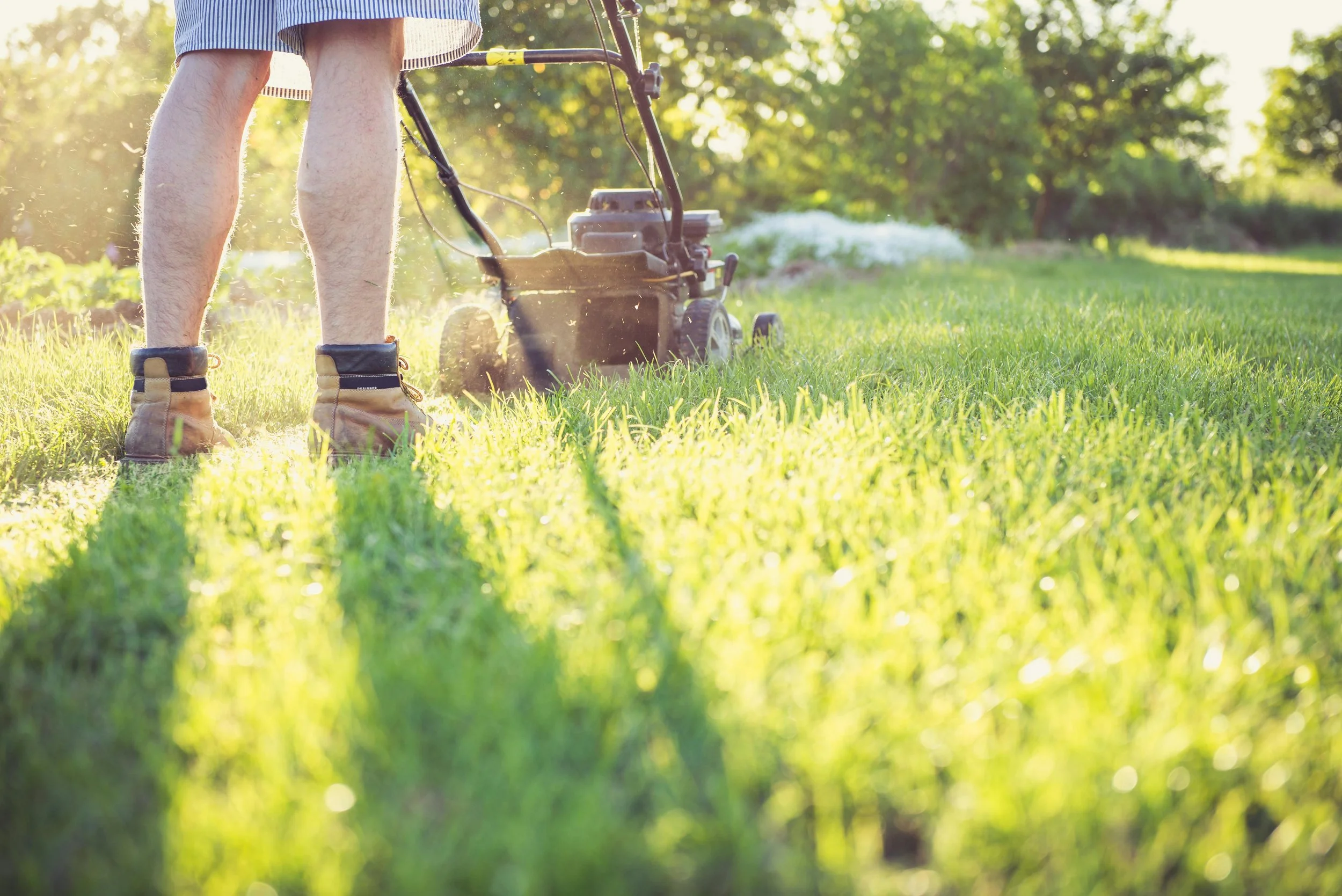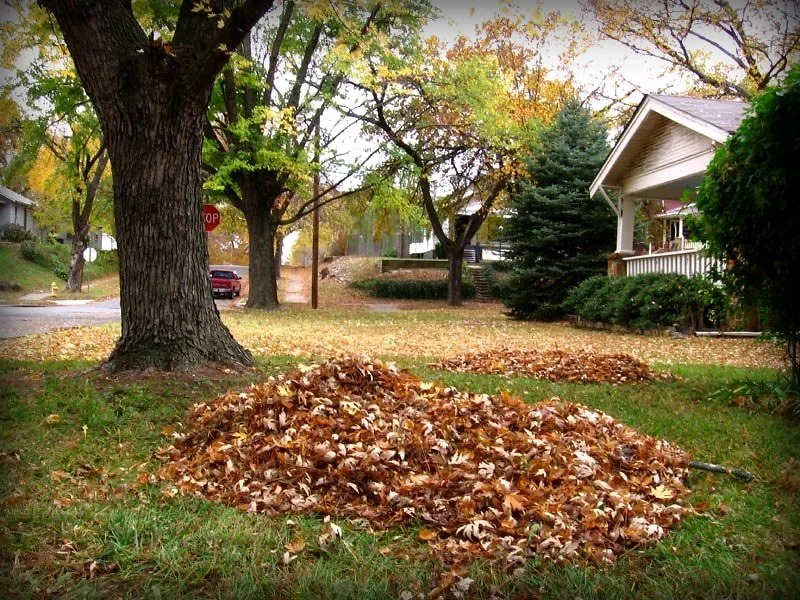Maintaining Low Maintenance Gardens
Here we go bagging on lawns again…
By Annie
Generally, gardens require maintenance year round to keep them looking good because plants grow, shed leaves, and sometimes even die despite our best efforts. Similarly our hardscape, such as paths, mulches and woodwork can need a little work to keep it looking good.
Whether it’s performed by you or a maintenance crew, there always seems to be something to do. So, when we talk about “low maintenance gardens” what exactly does that mean?
In this article I’ll compare and contrast two gardens with very different planting styles to illustrate the differences between them
Piles of leaves everywhere. Your deciduous trees are out to get you…
First let’s look at an average garden in the San Francisco Bay Area, where we are located. It has herbaceous borders using various flowering plants like annuals, roses and hydrangeas, deciduous trees, a 500 square foot lawn, a water feature and a seating area with a low hedge surrounding it. Occasional frosts occur at this garden.
This garden is high maintenance. To keep it looking manicured, the annual schedule of work will involve a monthly workday, and lawn mowing possibly as often as every other week. It looks something like this:
Spring:
Clean Up: Remove any debris, fallen leaves, and winter-killed plants.
Prune: Trim back overgrown shrubs and trees. Hedge maintenance starts now.
Fertilize: Apply a balanced fertilizer to nourish your plants.
Plant: Sow seeds or plant seedlings of annuals, perennials, and vegetables.
Weed: Pull out any weeds that have started to grow.
Mow the Lawn: Once the grass begins to grow, start mowing regularly.
Irrigation: Once the rains stop, the irrigation goes on - at least once a week for 30 minutes.
Summer:
Water: Water your plants deeply, especially during dry spells.
Weed: Continue to pull out weeds as they appear.
Mow the Lawn: Mow your lawn regularly, keeping it at the recommended height for your grass type.
Fertilize: Apply a slow-release fertilizer to feed your plants throughout the summer.
Spray: Roses and other plants may need to be regularly sprayed with insecticides and fungicides to prevent aphids, black spot and rust.
Deadhead: Remove spent blooms to encourage continuous flowering.
Prune: Prune summer-flowering shrubs after they bloom. The hedge is likely to need a trim now too.
Irrigation: The weekly irrigation continues.
Water feature: Refill and repair if needed.
Fall:
Clean Up: Rake up fallen leaves from the deciduous trees and other debris.
Prune: Cut back shrubs that are done flowering. Have another look at the hedge…
Fertilize: Apply a fall fertilizer to help your plants develop strong roots.
Plant Bulbs: Plant spring-flowering bulbs like tulips, daffodils, and hyacinths.
Mow the Lawn: Continue to mow your lawn until the grass stops growing.
Herbicide Application: Apply a pre-emergent herbicide to prevent weed growth in the spring.
Irrigation: The weekly irrigation continues.
Water feature: Remove leaves and clean.
Winter:
Protect Tender Plants: Cover tender plants with mulch or row covers to protect them from frost.
Clean Up: Remove any fallen debris and winter-damaged plants.
Prune: Prune any damaged or diseased branches.
Mow the Lawn: Stop mowing your lawn once the grass stops growing.
Irrigation: The weekly irrigation only stops when the winter rains start.
Lawn Care Basics
Mowing: The ideal mowing height varies depending on the type of grass. However, a general rule of thumb is to mow your lawn to a height of 2-3 inches.
Watering: Water your lawn deeply and infrequently, rather than shallowly and frequently. Aim for 1 inch of water per week. That’s 310 gallons per week for our 500 square foot lawn, or 16,120 gallons per year. Ugh.
Fertilizing: Fertilize your lawn 2-3 times per year, using a slow-release fertilizer.
Herbicide Application: Apply a pre-emergent herbicide in the spring to prevent weed growth. You may also need to apply a post-emergent herbicide to control weeds that have already emerged.
Some plants need a lot of help to stay alive, it seems.
Next, we can contrast that garden with a low maintenance garden in the same area. It has herbaceous borders using various low water flowering plants, native plants and desert-adapted species, along with evergreen trees, and no lawn but an open gravel seating area.
This garden needs much less work because the plants have been specifically selected to need little to no water, prefer poor soils (no fertilizer needed), are perfectly suited to the USDA zone this garden is in, and are evergreen so the amount of work needed to clean up after them is much reduced. To keep it looking great, the schedule is focused on Winter and Spring:
Spring:
Prune: Trim back overgrown shrubs and trees.
Weed: This is the main time of year to weed a low maintenance garden, as winter rains will have encouraged them. By early summer, the weeds will be gone, and with no irrigation they won’t be back till next winter.
Summer:
Deadhead: Remove spent blooms to encourage continuous flowering.
Fall:
Prune: Cut back shrubs that are done flowering.
Winter:
Prune: Any shrubs that still need to be cut back get cut now.
Weed: When the winter rains start, the weeds may emerge, so now is the time to get ahead of them by hand pulling them.
Zero water, low maintenance
As you can see, a low maintenance garden is likely to look great with 4-8 maintenance visits per year, and we really focus on Winter and Spring visits when rain causes weeds to sprout, whereas the high maintenance garden needs work to be done on it at least every 2 weeks, bringing the total number of visits to 26.
If you’re ready to reduce your maintenance time and costs, contact us and find out how we can make you a low water, low maintenance garden that still feels lush and beautiful.



